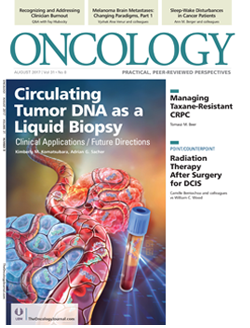COUNTERPOINT: Should Radiation Therapy After Surgery for Ductal Carcinoma In Situ Be Standard Practice?
To universally recommend breast irradiation for all women after excision of DCIS lesions ignores information now available to us that can spare the majority of women with DCIS the downsides of RT, but be applied in the treatment of DCIS patients at greater risk for invasive disease.
Oncology (Williston Park). 31(8):637, 640-641.

William C. Wood, MD

RT Should Not Be Standard Practice After Surgery for DCIS
Widespread use of screening mammography in the Western world has led to a flood of diagnoses of ductal carcinoma in situ (DCIS), yet many of these cases involve only small clusters of microcalcifications that the expertise of radiologists and the sophistication of their imaging units bring to light.[1] Surgical excision of DCIS, to ensure that a detected lesion does not harbor invasive carcinoma, is standard practice. Given the diversity in presenting manifestations of DCIS, in terms of the extent and grade of lesions and the wide age range of affected patients, is a blanket recommendation to treat patients with adjuvant radiation therapy (RT) wise in this setting? Guidelines from the National Comprehensive Cancer Network have been revised to offer more nuanced advice on the management of DCIS, recommending that adjuvant breast RT be considered (or not) based on the recurrence risk of the individual patient.[2]
If there were universal benefit to breast RT, without any detriment, a universal recommendation would make good sense. However, the ultimate benefit-improved survival-does not exist. Any survival benefit is offset by harms to survival; therefore, no net survival benefit is realized. Four randomized trials of postoperative RT vs no RT were analyzed by the Early Breast Cancer Trialists’ Collaborative Group. Although RT provided a clear reduction in the risk of any subsequent in-breast event (approximately 28% vs 13% without RT at 10 years; 2P < .00001), no survival advantage to RT was seen.[3] Indeed, some would object to the disadvantages to RT that emerged from this study; these included increased risks of lung, esophageal, and contralateral breast cancer; cardiovascular risks; and the rare risk of breast sarcoma.[4]
A universal recommendation aimed at reducing in-breast events from 28% to 13% in patients with DCIS would require delivering breast RT to 100 women to benefit 15. All 100 of those women would be at increased risk of cosmetic detriment, as evidenced by post-RT appearance rated “Fair to Poor” in 31% of patients in the Royal Marsden trial in 2005[5] and in 29% of those in the Canadian Trial in 2010.[6] Standard-fractionation whole-breast irradiation was associated with breast shrinkage at 10 years in 34% of patients in the START A trial and in 31% in the START B trial.[7] It is hoped that partial-breast irradiation will improve on these results, but since breast aesthetics are rated on the basis of contour and symmetry, it is not surprising that one randomized trial has already found cosmesis worse when compared with whole-breast irradiation. Techniques in breast irradiation are improving, and reduction of some of the current harms may be hoped for in future reports, but at least a decade of observation will be required to evaluate the impact of modified techniques of breast irradiation over the long term in DCIS.
A final caveat regarding an across-the-board recommendation for breast RT in DCIS concerns the women who experience a recurrence of any kind in the years following treatment. They will be likely to undergo mastectomy based on their prior RT rather than another excision and the possibility of additional irradiation.
All of these considerations argue for careful presentations of the options of therapy, including breast irradiation and/or hormonal therapy, in light of the specific patient risk factors, such as the extent of the DCIS lesion, the age of the patient, and the patient’s own preferences. Prognostic models have been sought, beginning with the Van Nuys Prognostic Index[8] and including the Memorial Sloan Kettering Cancer Center nomogram.[9] Although helpful, these have not been confirmed in multicenter studies of large populations, as illustrated by the challenge reported by Yi and colleagues in utilizing the Sloan Kettering nomogram for prediction of ipsilateral breast tumor recurrence in DCIS patients at MD Anderson Cancer Center.[10]
More recently, genomic analysis evolved into an important tool in the management of invasive breast cancer. In addition, there has been progress in efforts to define risk in DCIS using multigene assays; indeed, Dr. Clifford Hudis wrote a recent editorial in the New England Journal of Medicine called, “Biology Before Anatomy in Early Breast Cancer-Precisely the Point.”[11] The Oncotype DX DCIS Score was applied to tissue obtained in the Eastern Cooperative Oncology Group (ECOG) E5194 trial of DCIS treated with excision alone (or with surgery plus tamoxifen in 30% of the study cohort). This assay placed 70% of the patients into a low-risk group, in which only 3.7% developing invasive breast cancer in 10 years.[12] The Oncotype DX DCIS Score was further validated in 3,320 women from Ontario.[13] These lesions included larger areas of DCIS than in the ECOG trial and smaller margin requirements for excision (1 mm vs 3 mm in the ECOG trial). The low-risk group comprised 62% of the study population; these patients had only an 8% risk of progressing to invasive breast cancer and only a 12.7% risk of developing any in-breast lesion. This important information about biologic risk can be integrated with risk factors such as patient age, size of the lesion, and tumor multifocality to provide a more granular picture of the risk that DCIS poses to an individual patient.
Clearly, to universally recommend breast irradiation for all women after excision of DCIS lesions ignores information now available to us that can spare the majority of women with DCIS the downsides of RT, but be applied in the treatment of DCIS patients at greater risk for invasive disease.
Financial Disclosure:The author has no significant financial interest in or other relationship with the manufacturer of any product or provider of any service mentioned in this article.
References:
1. Sumner WE 3rd, Koniaris LG, Snell SE, et al. Results of 23,810 cases of ductal carcinoma-in-situ. Ann Surg Oncol. 2007;14:1638-43.
2. National Comprehensive Cancer Network. NCCN Clinical Practice Guidelines in Oncology. Breast cancer. Version 2.2017. Updated April 6, 2017. https://www.nccn.org/professionals/physician_gls/pdf/breast.pdf. Accessed July 9, 2017.
3. Early Breast Cancer Trialists’ Collaborative Group, Correa C, McGale P, et al. Overview of the randomized trials of radiotherapy in ductal carcinoma of the breast. J Natl Cancer Inst Monogr. 2010;2010:162-77.
4. Taylor C, Correa C, Duane FK, et al; Early Breast Cancer Trialists’ Collaborative Group. Estimating the risk of breast cancer radiotherapy: evidence from modern radiation doses to the lungs and heart and from previous randomized trials. J Clin Oncol. 2017 Mar 20. [Epub ahead of print]
5. Yarnold J, Ashton A, Bliss J, et al. Fractionation sensitivity and dose response of late adverse effects in the breast after radiotherapy for early breast cancer: long-term results of a randomised trial. Radiother Oncol. 2005;75:9-17.
6. Whelan TJ, Pignol JP, Levine MN, et al. Long-term results of hypofractionated radiation therapy for breast cancer. N Engl J Med. 2010;362:513-20.
7. Eblan MJ, VanderWalde NA, Zeman EM, Jones E. Hypofractionation for breast cancer: lessons learned from our neighbors to the north and across the pond. Oncology (Williston Park). 2014;28:536-46.
8. Silverstein MJ, Poller DN, Waisman JR, et al. Prognostic classification of breast ductal-carcinoma-in-situ. Lancet. 1995;345:1154-7.
9. Rudloff U, Jacks LM, Goldberg JI, et al. Nomogram for predicting the risk of local recurrence after breast-conserving surgery for ductal carcinoma in situ. J Clin Oncol. 2010;28:3762-9.
10. Yi M, Meric-Bernstam F, Kuerer HM, et al. Evaluation of a breast cancer nomogram for predicting the risk of ipsilateral breast tumor recurrences in patients with ductal carcinoma in situ after local excision. J Clin Oncol. 2012;30:600-7.
11. Hudis CA. Biology before anatomy in early breast cancer-precisely the point. N Engl J Med. 2015;373:2079-80.
12. Solin LJ, Gray R, Baehner FL, et al. A multigene expression assay to predict local recurrence risk for ductal carcinoma in situ of the breast.
J Natl Cancer Inst. 2013;105:701-10.
13. Rakovitch E, Nofech-Mozes S, Hanna W, et al. A population-based validation study of the DCIS Score predicting recurrence risk in individuals treated by breast-conserving surgery alone. Breast Cancer Res Treat. 2015;152:389-98.
